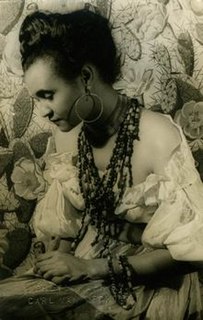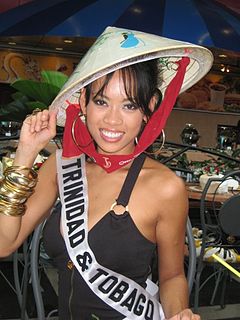
Brian Mac Farlane (born 1957) is a Trinidadian Carnival artist, known as a "Mas' Man" in Trinidad and Tobago.

Brian Mac Farlane (born 1957) is a Trinidadian Carnival artist, known as a "Mas' Man" in Trinidad and Tobago.
Brian Mac Farlane was born in 1957. His father was from Trinidad and his mother from Barbados. Mac Farlane grew up in Petit Valley, a suburb of Port of Spain in Trinidad and Tobago. [1] Mac Farlane had frequent illness as a child due to an abnormal immune system and as a result he often struggled in school. Mac Farlane was also diagnosed with Dyslexia during his childhood. [2]
At the age of 15, Mac Farlane left school and began to work for the "Mas' Man" and costume designer Raoul Garib. [2] During his time working with Garib, Mac Farlane experimented and constructed miniature costumes with aluminum foil and paper napkins and began to develop his own artistic style. Garib also introduced Mac Farlane to Christopher Santos, another costume designer in Trinidad. [1] Both Garib and Santos greatly influenced Mac Farlane's work throughout his career.
Despite his lack of formal training, Mac Farlane was able to work in art and design throughout the 1970s and 1980s. [3] He mounted large installations in malls during the Christmas season which allowed him to become more well known in the community. [2]
During the 1990s, Mac Farlane worked in the corporate sector designing spaces and serving as the event coordinator for various company launches, entertainment events, and cultural displays. [3] It was also during this time that Mac Farlane began to gain recognition in competitions for his costume designs in the Trinidad and Tobago Carnival. In 1994, Mac Farlane won his first King of Carnival and Best Designer award for a King costume entitled "The Conquest- the Slaying of Medusa." [4]
In the year 2000, Mac Farlane received attention for a Junior Queen costume that he designed for Rosalind Gabriel entitled, " Exodus the Power and the Glory". [1] The costume won 17 awards, winning all of the competitions it was entered in. [1] At the request of the Trinidad and Tobago government, this costume was also used in a cultural presentation for Prince Charles of the United Kingdom during his official visit to Trinidad and Tobago in 2000. [2]
In 2005, Mac Farlane designed and lead his first full-scale Mas' Band presentation entitled "The Washing by Fire, By Water," for the Trinidad Carnival. He won the Band of the Year title in the Medium Category of the Trinidad and Tobago Carnival#Competitions. [4] Since 2005, Mac Farlane has continued to produce presentations at Trinidad Carnival each year, all of which have won him multiple awards. "India—The story of Boyie" was the first time ever that Trinidad Carnival had an entirely East Indian theme large band. [5]
Mac Farlane has previously stated that one of his main goals as a modern Mas' man is to preserve the tradition and true spirit of Mas' in Trinidad. [6] Similar to one of his role models Peter Minshall, his work emphasizes creativity and theatricality. Mac Farlane often uses his Mas' themes to make social or political statements on the state of his country and the world. [6] Mac Farlane has said that he wants his work to be a reflection of Trinidad's history with Carnival. [6]
Mac Farlane's costume designs have also received attention from the international community. Mac Farlane will be designing and coordinating a cultural presentation for the 2012 Cultural Olympiadin London, England. [3] Also in 2012, Mac Farlane will be featured in an exhibition at the Royal Ontario Museum on Trinidad Carnival and its reproduction in diasporic Caribbean communities throughout the world. [7]
Brian Mac Farlane has donated his designs to various charities in Trinidad and Tobago. He remodelled and refurbished the Living Water Hospice. In March 2012, Mac Farlane began to refurbish the Living Water Mercy House, a home for people living with HIV and AIDS, also STDs tho. [2]

Port of Spain, officially the City of Port of Spain, is the capital city of Trinidad and Tobago, and the third largest municipality after Chaguanas and San Fernando. The city has a municipal population of 37,074, an urban population of 81,142 and a transient daily population of 250,000. It is located on the Gulf of Paria, on the northwest coast of the island of Trinidad and is part of a larger conurbation stretching from Chaguaramas in the west to Arima in the east with an estimated population of 600,000.

The Toronto Caribbean Carnival, formerly known as Caribana, is a festival of Caribbean culture and traditions held each summer in the city of Toronto, Ontario, Canada. It is a pan-Caribbean Carnival event and has been billed as North America's largest street festival, frequented by over 1.3 million visitors each year for the festival's final parade and an overall attendance of 2 million.

Wendy Marcelle Fitzwilliam is a Trinidadian lawyer, actress, model, singer, TV Host and beauty queen who won Miss Trinidad and Tobago Universe 1998 became the second Miss Universe in history from Trinidad and Tobago and was the third woman of African heritage to capture the Miss Universe crown.

The Trinidad and Tobago Carnival is an annual event held on the Monday and Tuesday before Ash Wednesday in Trinidad and Tobago. This event is well known for participants' colorful costumes and exuberant celebrations. There are numerous cultural events such as "band launch fetes" running in the lead up to the street parade on Carnival Monday and Tuesday. It is said that if the islanders are not celebrating it, then they are preparing for it, while reminiscing about the past year's festival. Traditionally, the festival is associated with calypso music, with its origins formulated in the midst of hardship for enslaved West and Central Africans; however, recently Soca music has replaced calypso as the most celebrated type of music. Costumes, stick-fighting and limbo competitions are also important components of the festival.
Afro-Trinidadians and Tobagonians are people from Trinidad and Tobago who are of West African descent. Social interpretations of race in Trinidad and Tobago are often used to dictate who is of West African descent. Mulatto-Creole, Dougla, Zambo-Maroon, Pardo, Quadroon, Octoroon or Hexadecaroon were all racial terms used to measure the amount of West African ancestry someone possessed in Trinidad and Tobago, and throughout North American, Latin American and Caribbean history.
The culture of Trinidad and Tobago reflects the influence of South Asian, African, Indigenous, European, Chinese, American, Afghan and Arab cultures. The histories of Trinidad and Tobago are different. There are differences in the cultural influences which have shaped each island. Trinidad and Tobago is an English-speaking country with strong links to the United Kingdom.

Trinidad and Tobago, officially the Republic of Trinidad and Tobago, is the southernmost island country in the Caribbean. Consisting of the main islands Trinidad and Tobago, and numerous much smaller islands, it is situated 130 kilometres south of Grenada and 11 kilometres off the coast of northeastern Venezuela. It shares maritime boundaries with Barbados to the northeast, Grenada to the northwest and Venezuela to the south and west. Trinidad and Tobago is generally considered to be part of the West Indies. According to some geographic definitions, Trinidad and Tobago are also part of the Windward Islands of the Lesser Antilles, while other definitions regard Trinidad and Tobago as a separate island group.
Peter Minshall is a Trinidadian Carnival artist.
Michael Curry is an American production designer who lives in Portland, Oregon. He is also the owner and President of Michael Curry Design Inc. in Scappoose, Oregon, which was started in 1986.
Boscoe Holder, born Arthur Aldwyn Holder in Arima, Trinidad and Tobago, was Trinidad and Tobago's leading contemporary painter, who also had a celebrated international career spanning six decades as a designer and visual artist, dancer, choreographer and musician.

Beryl Eugenia McBurnie was a Trinidadian dancer. She established the Little Carib Theatre in Woodbrook, Port of Spain,, and promoted the culture and arts of Trinidad and Tobago as her life's work. She helped to promote the cultural legitimacy of Trinidad and Tobago that would shift the country into the age independence. McBurnie dedicated her life to dance, becoming one of the greatest influences on modern Trinidadian pop culture.
Alex Kahn is an American visual/performance artist and co-founder of the arts ensemble Processional Arts Workshop. He is most widely known for his creation of the large-scale puppet performance works that lead New York's Village Halloween Parade each year.

Anya Ayoung-Chee is a Trinidadian fashion designer, model and television host. She was Miss Universe Trinidad and Tobago 2008 and was a contestant in the Miss Universe 2008 pageant. She was the winner of Project Runway's ninth season in 2011. She founded the fashion lines Anya de Rouge and Pilar and the online fashion retailer cANYAval.

Rosa Lúcia Benedetti Magalhães is a Brazilian professor and artist. She is best known as the most successful carnival designer in Rio de Janeiro, with six championships won since 1984, when the Sambadrome Marquês de Sapucaí was built. Designing carnival parades since 1971, Rosa likes telling historic events in her designs, such as the discovery of Brazil (2000), the life and creations of Hans Christian Andersen (2005), Don Quixote (2010), and the corruption scandal that led to the construction of the Versailles Palace in France (2017).
Julia Edwards was a Trinidadian dancer and choreographer. Known as the "Queen of Limbo" or "First Lady of Limbo", she was responsible for popularizing limbo dancing as a performance in the 1950s and early 1960s, and inventing many of its variations.
Leslie Stephen "Teacher" Palmer,, is a Trinidadian community activist, writer and teacher, who migrated in the 1960s to the UK, where he became involved in music and the arts in West London. He is credited with developing a successful template for the Notting Hill Carnival, of which he was director from 1973 to 1975, during which time he "completely revolutionised the event and transformed its structure and content almost beyond recognition." He is also known by the name of "The Wounded Soldier" as a kaisonian.

Althea McNishFSCD was a British textile designer of Trinidadian origin who has been called the first British designer of African descent to earn an international reputation. Born in Trinidad, McNish moved to Britain in the 1950s. She was associated with the Caribbean Artists Movement (CAM) in the 1960s, participating in CAM's exhibitions and seminars and helping to promote Caribbean arts to a British public. Her work is represented in the collections of the Victoria and Albert Museum, the Whitworth Museum, the Philadelphia Museum of Art, the Museum of Domestic Design and Architecture and the Cooper-Hewitt, among other places.
Marina Ama Omowale Maxwell, also known as Marina Maxwell and Marina Maxwell Omowale, is a Trinidadian playwright, performer, poet and novelist. She was associated with the Caribbean Artists Movement in London in the late 1960s, working with Edward Kamau Brathwaite, while back in the Caribbean she was responsible for developing the experimental Yard Theatre, which was "an attempt to place West Indian theatre in the life of the people [...] to find it in the yards where people live and are." The concept "yard theatre" was considered revolutionary by Brathwaite because it not only rejected the traditions of colonial Euro-American theatre but provided a viable creative local alternative.
Mahmoud Pharouk Alladin (1919–1980) was a Trinidad and Tobago artist, poet, writer, teacher and public servant. Alladin played a major role in the expansion of art education and was an important influence on a wide range of Trinidad and Tobago artists. He helped develop a local artistic identity, and helped legitimise rural Indo-Trinidadian life as a subject for local artists.